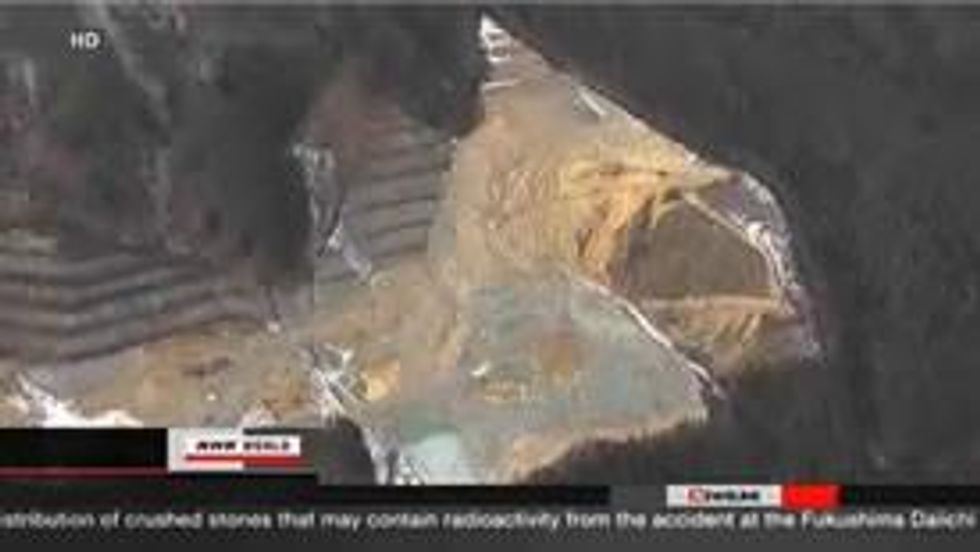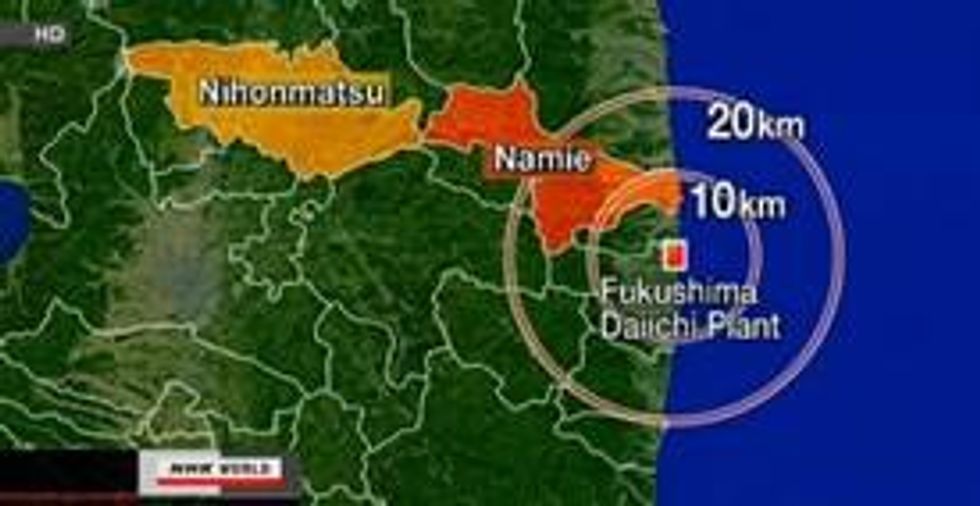

SUBSCRIBE TO OUR FREE NEWSLETTER
Daily news & progressive opinion—funded by the people, not the corporations—delivered straight to your inbox.
5
#000000
#FFFFFF
To donate by check, phone, or other method, see our More Ways to Give page.


Daily news & progressive opinion—funded by the people, not the corporations—delivered straight to your inbox.
The Japanese government announced today that radioactive concrete has been used to construct new apartment buildings in the Fukushima Prefecture, housing evacuees from a town near the site of the multiple nuclear plant meltdowns.
NHK (the Japan Broadcasting Company) is reporting Monday:
The Japanese government is investigating the distribution of crushed stones that may contain radioactivity from the accident at the Fukushima Daiichi nuclear power plant. It has found that concrete made of the stones has been sold to more than 200 firms.
The probe comes after radioactive cesium was detected in a new apartment building in Nihonmatsu, Fukushima Prefecture where the concrete was used. Readings of up to 1.24 microsieverts per hour have been recorded inside the building which is higher than outside.
"We thought we could finally settle here. I have no words," said a resident, who told broadcaster NHK she moved to the apartment with her husband and young children, to escape radiation. "I just feel so awful for my kids. I feel like I've failed as a parent."The gravel comes from a quarry in Namie that was designated as an evacuation zone in April.
The quarry operator says it shipped more than 5,000 tons of crushed stones to 19 firms in the weeks after the accident. The government has set no limit on radiation in stones and sand used for construction even after the nuclear accident.
The company president told reporters on Monday that he never imagined that stones from his quarry would cause such a problem and that he wants to apologize to residents of the building for their exposure to radiation.
The economy ministry says 2 of the 19 firms sold concrete made of the stones to more than 200 companies. It believes that the concrete was used in housing construction and on roads.
And Japan's Kyodo news service reports:
FUKUSHIMA -- High levels of radiation have been detected on the first floor of a newly built condominium complex in Nihonmatsu, Fukushima Prefecture, the municipal government said.

A quarry firm said Monday it shipped some 5,280 tons of crushed stones from Namie, Fukushima Prefecture, to 19 contractors after the nuclear crisis started last March 11, including some 1,065 tons distributed to a concrete maker that provided the material for the Nihonmatsu building's foundations. [...]
The city conducted the checks after a junior high school girl living on its first floor logged an exposure reading of 1.62 millisieverts during a three-month period from September, the local authority said.
Agence France-Presse reports:

Radiation levels of up to 1.24 microsieverts per hour were recorded in the building in Nihonmatsu, Fukushima, 55 kilometres (35 miles) from the crippled power plant, local authorities said Sunday. [...]
Radiation fears have since become part of daily life in Japan after cases of contaminated water, beef, vegetables, tea and seafood were discovered.
The government has consistently been at pains to stress the lack of an "immediate" health risk, but has been faced by scepticism from the public.
Dear Common Dreams reader, The U.S. is on a fast track to authoritarianism like nothing I've ever seen. Meanwhile, corporate news outlets are utterly capitulating to Trump, twisting their coverage to avoid drawing his ire while lining up to stuff cash in his pockets. That's why I believe that Common Dreams is doing the best and most consequential reporting that we've ever done. Our small but mighty team is a progressive reporting powerhouse, covering the news every day that the corporate media never will. Our mission has always been simple: To inform. To inspire. And to ignite change for the common good. Now here's the key piece that I want all our readers to understand: None of this would be possible without your financial support. That's not just some fundraising cliche. It's the absolute and literal truth. We don't accept corporate advertising and never will. We don't have a paywall because we don't think people should be blocked from critical news based on their ability to pay. Everything we do is funded by the donations of readers like you. Will you donate now to help power the nonprofit, independent reporting of Common Dreams? Thank you for being a vital member of our community. Together, we can keep independent journalism alive when it’s needed most. - Craig Brown, Co-founder |
The Japanese government announced today that radioactive concrete has been used to construct new apartment buildings in the Fukushima Prefecture, housing evacuees from a town near the site of the multiple nuclear plant meltdowns.
NHK (the Japan Broadcasting Company) is reporting Monday:
The Japanese government is investigating the distribution of crushed stones that may contain radioactivity from the accident at the Fukushima Daiichi nuclear power plant. It has found that concrete made of the stones has been sold to more than 200 firms.
The probe comes after radioactive cesium was detected in a new apartment building in Nihonmatsu, Fukushima Prefecture where the concrete was used. Readings of up to 1.24 microsieverts per hour have been recorded inside the building which is higher than outside.
"We thought we could finally settle here. I have no words," said a resident, who told broadcaster NHK she moved to the apartment with her husband and young children, to escape radiation. "I just feel so awful for my kids. I feel like I've failed as a parent."The gravel comes from a quarry in Namie that was designated as an evacuation zone in April.
The quarry operator says it shipped more than 5,000 tons of crushed stones to 19 firms in the weeks after the accident. The government has set no limit on radiation in stones and sand used for construction even after the nuclear accident.
The company president told reporters on Monday that he never imagined that stones from his quarry would cause such a problem and that he wants to apologize to residents of the building for their exposure to radiation.
The economy ministry says 2 of the 19 firms sold concrete made of the stones to more than 200 companies. It believes that the concrete was used in housing construction and on roads.
And Japan's Kyodo news service reports:
FUKUSHIMA -- High levels of radiation have been detected on the first floor of a newly built condominium complex in Nihonmatsu, Fukushima Prefecture, the municipal government said.

A quarry firm said Monday it shipped some 5,280 tons of crushed stones from Namie, Fukushima Prefecture, to 19 contractors after the nuclear crisis started last March 11, including some 1,065 tons distributed to a concrete maker that provided the material for the Nihonmatsu building's foundations. [...]
The city conducted the checks after a junior high school girl living on its first floor logged an exposure reading of 1.62 millisieverts during a three-month period from September, the local authority said.
Agence France-Presse reports:

Radiation levels of up to 1.24 microsieverts per hour were recorded in the building in Nihonmatsu, Fukushima, 55 kilometres (35 miles) from the crippled power plant, local authorities said Sunday. [...]
Radiation fears have since become part of daily life in Japan after cases of contaminated water, beef, vegetables, tea and seafood were discovered.
The government has consistently been at pains to stress the lack of an "immediate" health risk, but has been faced by scepticism from the public.
The Japanese government announced today that radioactive concrete has been used to construct new apartment buildings in the Fukushima Prefecture, housing evacuees from a town near the site of the multiple nuclear plant meltdowns.
NHK (the Japan Broadcasting Company) is reporting Monday:
The Japanese government is investigating the distribution of crushed stones that may contain radioactivity from the accident at the Fukushima Daiichi nuclear power plant. It has found that concrete made of the stones has been sold to more than 200 firms.
The probe comes after radioactive cesium was detected in a new apartment building in Nihonmatsu, Fukushima Prefecture where the concrete was used. Readings of up to 1.24 microsieverts per hour have been recorded inside the building which is higher than outside.
"We thought we could finally settle here. I have no words," said a resident, who told broadcaster NHK she moved to the apartment with her husband and young children, to escape radiation. "I just feel so awful for my kids. I feel like I've failed as a parent."The gravel comes from a quarry in Namie that was designated as an evacuation zone in April.
The quarry operator says it shipped more than 5,000 tons of crushed stones to 19 firms in the weeks after the accident. The government has set no limit on radiation in stones and sand used for construction even after the nuclear accident.
The company president told reporters on Monday that he never imagined that stones from his quarry would cause such a problem and that he wants to apologize to residents of the building for their exposure to radiation.
The economy ministry says 2 of the 19 firms sold concrete made of the stones to more than 200 companies. It believes that the concrete was used in housing construction and on roads.
And Japan's Kyodo news service reports:
FUKUSHIMA -- High levels of radiation have been detected on the first floor of a newly built condominium complex in Nihonmatsu, Fukushima Prefecture, the municipal government said.

A quarry firm said Monday it shipped some 5,280 tons of crushed stones from Namie, Fukushima Prefecture, to 19 contractors after the nuclear crisis started last March 11, including some 1,065 tons distributed to a concrete maker that provided the material for the Nihonmatsu building's foundations. [...]
The city conducted the checks after a junior high school girl living on its first floor logged an exposure reading of 1.62 millisieverts during a three-month period from September, the local authority said.
Agence France-Presse reports:

Radiation levels of up to 1.24 microsieverts per hour were recorded in the building in Nihonmatsu, Fukushima, 55 kilometres (35 miles) from the crippled power plant, local authorities said Sunday. [...]
Radiation fears have since become part of daily life in Japan after cases of contaminated water, beef, vegetables, tea and seafood were discovered.
The government has consistently been at pains to stress the lack of an "immediate" health risk, but has been faced by scepticism from the public.